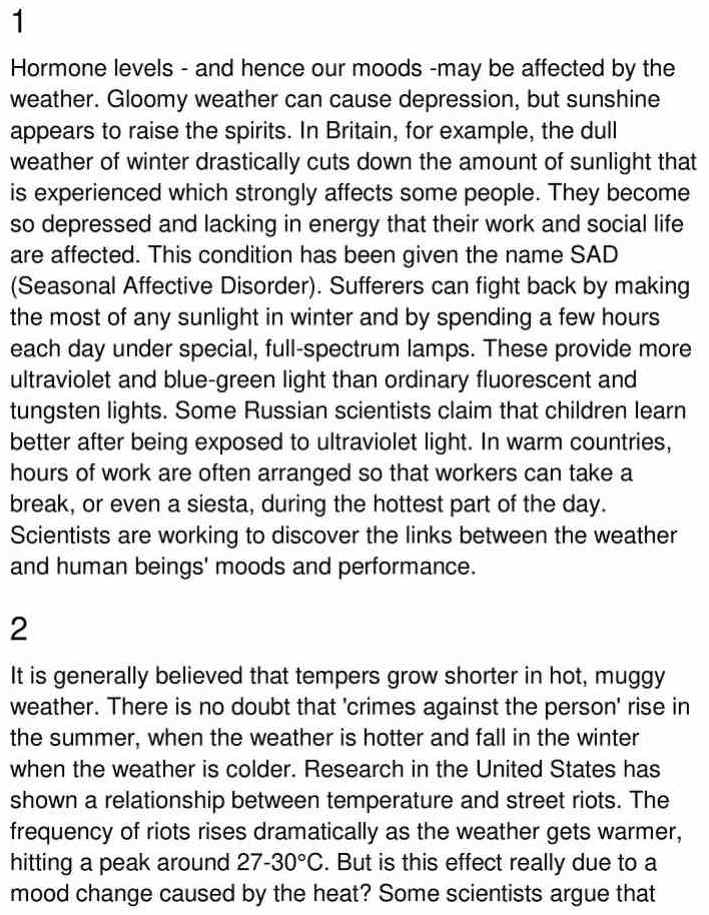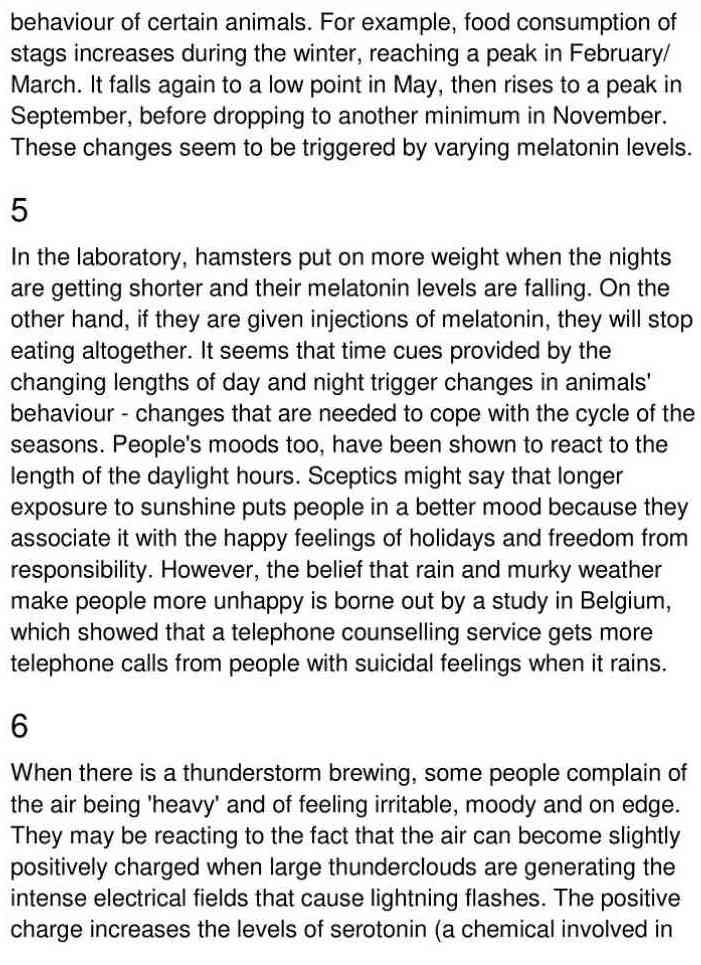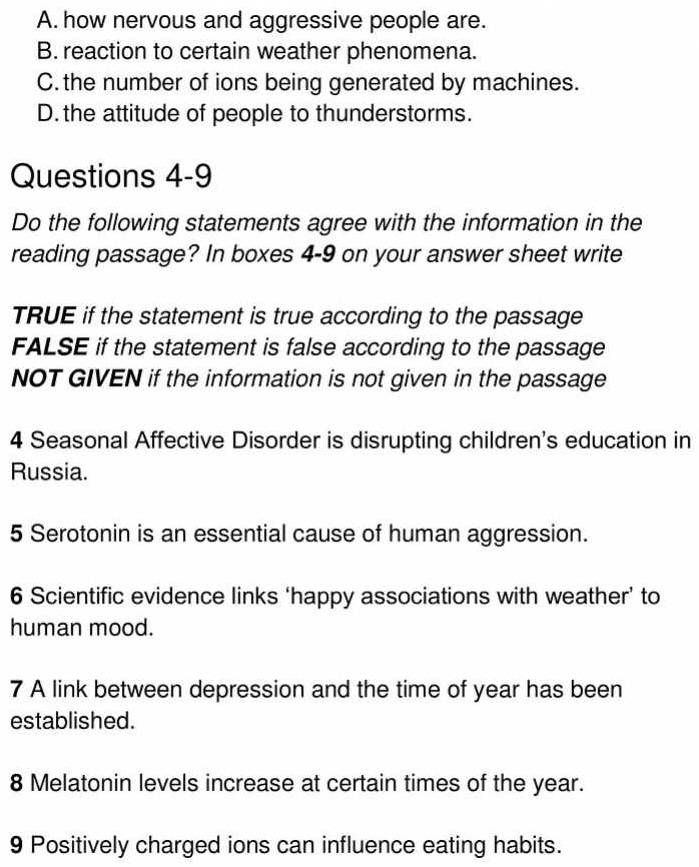Highs and Lows – IELTS Reading Answers
6 min read
Updated On
-
Copy link
Table of Contents

Limited-Time Offer : Access a FREE 10-Day IELTS Study Plan!
The Academic passage ‘Highs and Lows’ is a reading passage that appeared in an IELTS Test. Try to find the answers to get an idea of the difficulty level of the passages in the actual reading test. If you want more passages to solve, try taking one of our IELTS reading practice tests.
You should spend around 20 minutes to answer questions 1-15 given in the reading passage below.
Highs and Lows







Answers
Unlock Answers
| Question Number | Answer | Explanation |
|---|---|---|
| 1 | A | Paragraph 3 mentions that researchers compared divers working in icy cold water at 5°C with others in water at 20°C (about swimming pool temperature). Their performance was impaired as soon as they were put into the cold water – before their bodies had time to cool down. This suggests that the ‘low temperature’ did not slow down mental functioning directly, but the feeling of cold ‘distracted the divers from their tasks’, that is, they were not able to concentrate on their task. Hence, the answer is A (They were less able to concentrate). |
| 2 | B | Paragraph 4 presents the link between weather and mood is made believable by the ‘evidence for a connection between behaviour and the length of the daylight hours’, which might involve the level of a hormone called melatonin, produced in the pineal gland in the brain. The ‘amount of melatonin falls with greater exposure to daylight’. Research shows that melatonin plays an important part in the seasonal behaviour of certain animals. For example, ‘food consumption of stags increases during the winter’, reaching a peak in February/ March. It ‘falls again to a low point in May’. These changes seem to be triggered by varying melatonin levels which are affected by the exposure to daylight. Hence, the answer is B (influences animal feeding habits). |
| 3 | B | Paragraph 2 states a general belief that ‘tempers’ (irritability) ‘grow shorter in hot, muggy weather’, which results ‘crimes against the person’ rise in the summer, when the weather is hotter and ‘fall in the winter when the weather is colder’. Research in the United States has shown a relationship between temperature and street riots. The ‘frequency of riots rises dramatically as the weather gets warmer’, hitting a peak around 27-30°C. So, human irritability increases with warm or hot weather. Hence, the answer is B (reaction to certain weather phenomena). |
| 4 | NOT GIVEN | In paragraph 1, the author writes that the dull weather of winter drastically cuts down the amount of sunlight that is experienced which strongly affects some people. They become so depressed and lacking in energy that their work and social life are affected. ‘This condition has been given the name SAD (Seasonal Affective Disorder)’. The reference to Russia is given in the same paragraph as it states that some ‘Russian scientists claim that children learn better after being exposed to ultraviolet light’. As these references (SAD and Russian children) are not related, the answer is ‘NOT GIVEN’. |
| 5 | TRUE | Paragraph 6 informs that high levels of serotonin in certain areas of the nervous system ‘make’ (cause) ‘people’ (human) more active and reactive and, possibly, ‘more aggressive’. As the statement is true according to the passage, the answer is ‘TRUE’. |
| 6 | FALSE | Paragraph 5 points out that sceptics, that is people who are inclined to question or doubt accepted opinions’, ‘might say’ (there is a sense of doubt) that ‘longer exposure to sunshine puts people in a better mood because they associate it with the happy feelings’ of holidays and freedom from responsibility. So, this is the opinion of sceptics and there is no scientific evidence behind it. As the statement is false according to the passage, the answer is ‘FALSE’. |
| 7 | TRUE | Paragraph 1 cites the example of Britain and states that the ‘dull weather of winter’ (certain time of year) drastically ‘cuts down the amount of sunlight’ which strongly affects some people. They ‘become so depressed and lacking in energy’ (depressive mood) that their work and social life are affected. This condition has been given the name SAD (Seasonal Affective Disorder). This example proves that during certain times of the year people get depressed due to changes in weather and so there is a link between those two (time of the year and depression). As the statement is true according to the passage, the answer is ‘TRUE’. |
| 8 | TRUE | Paragraph 4 refers to the fact that the ‘amount of melatonin falls with greater exposure to daylight’. So, we can conclude that the amount of melatonin rises with low exposure to daylight or sunlight. As the statement is true according to the passage, the answer is ‘TRUE’. |
| 9 | NOT GIVEN | The only reference to ions is present in the sixth paragraph of the passage which mentions that in the United Kingdom, 400,000 ionizers are sold every year. These small machines raise the number of negative ions in the air in a room. As there is no mention of positive ions or their influence on eating habits, the answer is ‘NOT GIVEN’. |
| 10 | B | Paragraph 5 studies the belief that ‘rain and murky weather make people more unhappy’ is borne out by a research in Belgium, which showed that a telephone counselling service gets more telephone calls from ‘people with suicidal feelings when it rains’. Therefore, people undergo psychological changes during rainy weather which tend to make them more unhappy and suicidal. Hence, the answer is B (rainy weather). |
| 11 | D | Paragraph 6 indicates that ‘high levels of serotonin’ in certain areas of the nervous system ‘make people more active and reactive’ and they may also become ‘more aggressive’. So, we can conclude that high levels of serotonin affects the psychological aspect of a person. Hence, the answer is D (high serotonin levels). |
| 12 | E | Paragraph 4 declares that psychologists have conducted ‘studies showing’ that ‘people become less sceptical and more optimistic when the weather is sunny’. Thus, a conclusion can be made that exposure to bright daylight can affect people’s psychology. Hence, the answer is E (sunny weather). |
| 13 | B | Paragraph 2 presents that research ‘in the United States’ has ‘shown’ (established) a ‘relationship between temperature and street riots’ (social tension). The ‘frequency of riots rises’ dramatically as the ‘weather gets warmer’, hitting a peak around 27-30°C.
Hence, the answer is B (hot weather). |
| 14 | A | Paragraph 5 brings out the fact that in the laboratory, ‘hamsters’ ‘put on more weight’ (bodyweight increases) when the ‘nights are getting shorter’ which means there is more daylight and their ‘melatonin levels are falling’ (in paragraph 4, it is given that the amount of melatonin falls ‘with greater exposure to daylight’). So, both the conditions prove that the body weight increases when the hamster is exposed to daylight. Hence, the answer is A (daylight). |
| 15 | F | In paragraph 5, the author provides an example of hamsters putting on more weight when the nights are getting shorter and their ‘melatonin levels are falling’ which in turn affect the food habits of animals. The author proves the link between melatonin and food consumption with an example in paragraph 4 – food consumption of stags increases during the winter, reaching a peak in February/ March. It is further mentioned in paragraph 5, that , ‘time cues’ (seasons, time of the year, exposure to daylight) provided by the ‘changing lengths of day and night’ trigger ‘changes in animals’ behaviour’ – changes that are needed to cope with the cycle of the seasons. Hence, the answer is F (time cues). |
Check More IELTS Reading Answers
Also check :
Practice IELTS Reading based on question types

Start Preparing for IELTS: Get Your 10-Day Study Plan Today!
Recent Articles

Nehasri Ravishenbagam

Haniya Yashfeen

Haniya Yashfeen

Haniya Yashfeen




Post your Comments